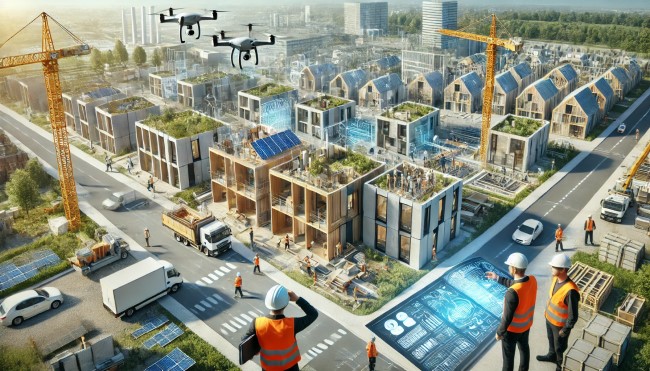Stichting Bouwresearch: Revolutionizing the Dutch Construction Industry

Stichting Bouwresearch (SBR) stands as one of the most impactful research institutions in the Netherlands, dedicated to advancing construction techniques, sustainability, and innovation. Throughout its existence, SBR shaped the construction landscape and set a benchmark for other countries to follow. The organization’s dedication to research, development, and collaboration with industry partners has left an indelible mark on the global construction industry. This article delves into the legacy, mission, achievements, and future influence of Stichting Bouwresearch.
The Origins of Stichting Bouwresearch
Stichting Bouwresearch was founded in 1946 in Rotterdam, aiming to address the challenges posed by the construction industry post-World War II. The organization started as a partnership between architects, engineers, and government agencies to innovate building techniques, improve construction standards, and address urgent housing shortages. Over the years, it moved its headquarters to Delft, a technological hub that provided access to cutting-edge research and innovation facilities.
Mission and Vision: Driving Innovation Through Research
Stichting Bouwresearch’s mission was to enhance building quality, efficiency, and sustainability. The organization focused on fundamental research areas, such as energy efficiency, digitalization, safety, and sustainable construction. Its overarching vision was to lead the Dutch construction industry into a future of eco-friendly, innovative, and resilient structures.
Key objectives of Stichting Bouwresearch included:
- Conducting applied research on materials and construction techniques.
- Setting standards and developing guidelines to improve building quality.
- Promoting sustainable construction practices.
- Collaborating with educational institutions to foster innovation.
- Influencing government policies related to the built environment.
Achievements in Sustainable Construction
One of the hallmarks of Stichting Bouwresearch was its leadership in promoting sustainable construction. The organization pioneered research on energy-efficient buildings, promoting using renewable energy sources and green building materials.
Green Building Practices
SBR advocated for the integration of green materials and techniques in construction. For example, the organization researched the use of timber in multi-story buildings, a sustainable alternative to conventional materials like concrete. Additionally, SBR explored the concept of “circular construction,” where buildings are designed with recycled materials and can be easily disassembled, reducing the overall environmental footprint.
Energy Efficiency
Energy efficiency was another area in which SBR made significant contributions. The organization’s research helped shape Dutch building codes that emphasized reducing energy consumption in residential and commercial properties. Their work introduced energy performance standards, leading to the adoption of technologies like geothermal heat pumps, solar panels, and energy-efficient HVAC systems.
Innovations in Construction Technology
Stichting Bouwresearch also had a hand in pushing forward technological advancements within the construction industry. From the early use of Building Information Modeling (BIM) to embracing 3D printing technology, SBR’s research into digital construction practices revolutionized how buildings were designed, constructed, and maintained.
Digitalization and Industrialization
SBR was an advocate for digitalization in construction. To reduce construction time, the organization led initiatives to integrate digital tools such as drones for site monitoring, BIM for design optimization, and prefabrication methods. Prefabrication, in particular, allowed for faster assembly of building components, improved precision, and cost reductions.
Building Information Modeling (BIM)
One of the breakthroughs facilitated by SBR was the adoption of BIM technology, which revolutionized the planning, design, and management of construction projects. BIM allows for creating detailed digital models of buildings, enabling architects, engineers, and builders to collaborate more effectively, reduce errors, and optimize resources.
Safety Standards and Worker Well-being
In addition to technological advancements, Stichting Bouwresearch played a crucial role in improving construction site safety. The organization developed standards for personal protective equipment (PPE), and its research on ergonomic work environments and safer construction processes contributed to reducing workplace accidents and improving worker well-being.
The Role of Collaboration and Knowledge Sharing
A key strength of Stichting Bouwresearch was its ability to foster collaboration between academia, government bodies, and the private sector. The organization acted as a hub for knowledge exchange in the Dutch construction industry by organizing conferences and workshops and publishing research findings.
Partnerships with Educational Institutions
SBR worked closely with universities and research institutions, helping to create curricula that reflected the latest trends in the built environment. The organization facilitated internships and mentorship programs, providing students with hands-on experience in construction research. This approach ensured that future generations of architects, engineers, and construction professionals were well-prepared to tackle emerging challenges.
International Influence
While SBR’s focus was primarily on the Dutch construction industry, its influence extended far beyond the borders of the Netherlands. The organization collaborated with international partners to address global issues such as climate change, sustainable development, and affordable housing. Stichting Bouwresearch helped other countries improve their construction methods and standards by sharing its research and best practices.
Notable Projects and Research Contributions
Over the decades, Stichting Bouwresearch was involved in numerous groundbreaking projects that reshaped the construction landscape. Some of its notable contributions include:
- Timber in High-Rise Buildings: SBR’s research demonstrated the viability of using timber in high-rise construction, reducing the environmental impact of buildings and promoting the use of renewable materials.
- Retrofit Projects: The organization retrofitted older buildings with energy-efficient systems, making them more sustainable and reducing operational costs for owners and tenants.
- Modular Construction: SBR collaborated on projects involving modular construction techniques, significantly reducing construction timelines while maintaining high quality.
The Legacy and Closure of Stichting Bouwresearch
Despite its remarkable contributions, Stichting Bouwresearch faced significant challenges in the 2000s, as the construction industry became more privatized and funding for public research initiatives dwindled. In 2017, the organization closed its doors. However, its legacy lives on through various successor organizations, including TNO Built Environment, which continues its research on sustainable construction and building performance, and NEN, which maintains the building codes SBR helped establish.
Conclusion: Shaping the Future of Construction
Stichting Bouwresearch’s impact on the construction industry remains profound. Through its innovative research, collaboration, and commitment to sustainability, the organization has left an enduring legacy that continues to influence construction practices today. Although it closed in 2017, SBR’s work is carried forward by other institutions, ensuring that sustainability, safety, and innovation remain at the forefront of modern construction.
As urbanization, climate change, and technological advancements continue to shape the future, the lessons learned from Stichting Bouwresearch’s decades of research and development will remain critical in creating a built environment that is resilient, efficient, and sustainable for generations to come.

